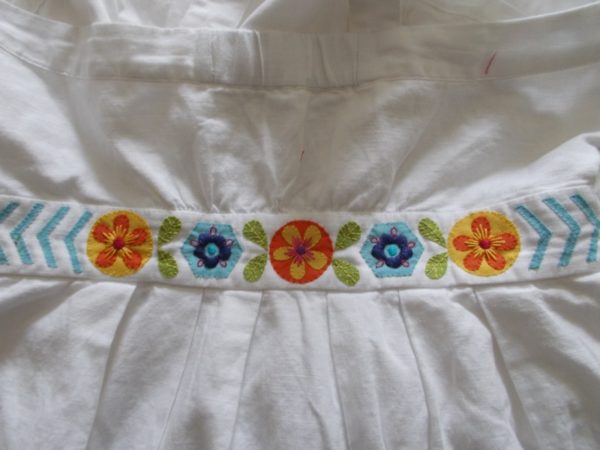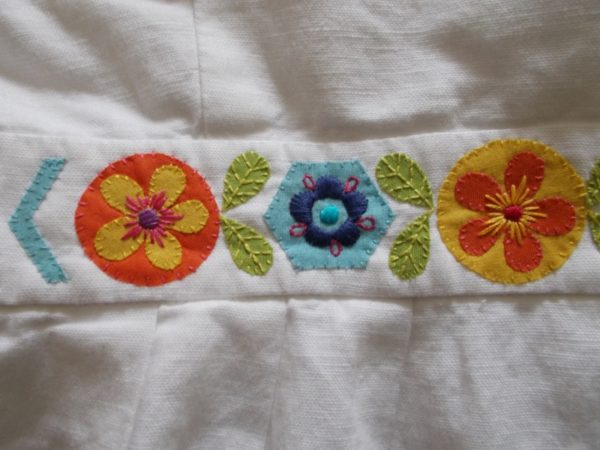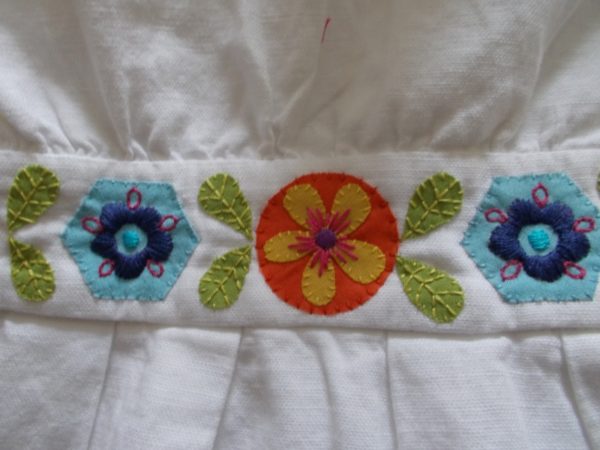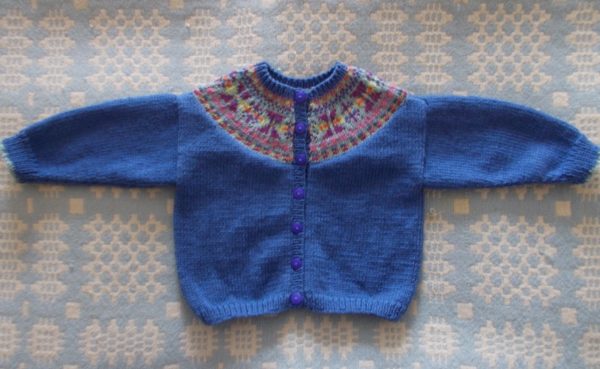
Cardigan with Fair Isle Yoke 9-12 months from Debbie Bliss Baby Cashmerino (pub 2001) Fair Isle design taken from Mary Jane Mucklestone’s 200 Fair Isle Designs
This is the seventh cardigan I’ve made to the same – my favourite – Debbie Bliss pattern (from Debbie Bliss Baby Cashmerino, pub. 2002) and it was just as enjoyable to knit the seventh time as it was the first. With the back and fronts knitted as one piece there’s little seam sewing and I love the way the yoke patterning appears with minimal need for counting stitches. As I like to see a nice deep patterned yoke I started the Fair Isle patterning on the row immediately after picking up stitches on the back and front and continued patterning up to the row before beginning the rib for the neckband. The only other thing I did differently was to cast off the 13 stitches across the back (which the pattern tells you to leave on a stitch holder) because I prefer how it looks that way. Lovely purply-blue buttons come from Ray Stitch in Islington. I used to use mother-of-pearl but I find for baby knitwear the smooth edges of these buttons make them easier to get through the button holes, especially if the baby is lively.
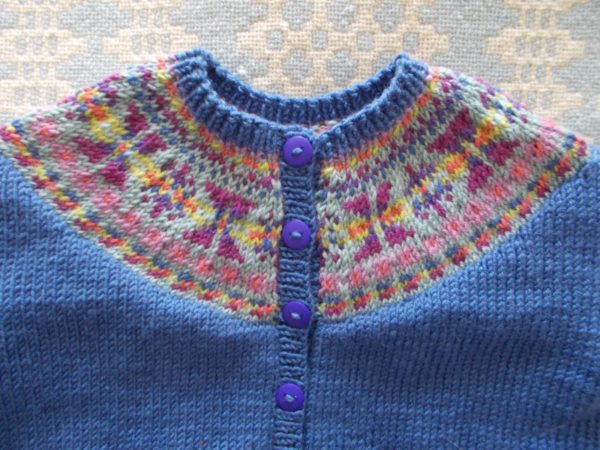
Detail : Cardigan with Fair Isle Yoke 9-12 months from Debbie Bliss Baby Cashmerino (pub 2001) Fair Isle design taken from Mary Jane Mucklestone’s 200 Fair Isle Designs
Meanwhile my knitting pleasure has been boosted by the return of cricket to the air waves. As in previous summers, household tasks, shopping, walks and preparatory sewing are timed to fit around Test Match cricket commentary on the radio. I was brought up with a brother (7 years older) at Nottingham Boys’ High School (a public school, i.e. a private fee-paying school, but he was a scholarship boy so we paid nothing) and as my mother worked one day a week, on a Saturday, in a shop selling wedding dresses (which job she loved) I would go almost every Saturday in term time with my father to watch my brother play cricket in summer and rugby in winter, home and often away.

Detail showing back yoke: Cardigan with Fair Isle Yoke 9-12 months from Debbie Bliss Baby Cashmerino (pub 2001) Fair Isle design taken from Mary Jane Mucklestone’s 200 Fair Isle Designs
I came to enjoy both sports but the whole ambiance surrounding cricket was particularly enjoyable. As soon as we got to the ground I would leave my father with fellow fathers on the boundary while I enjoyed wandering round, looking at wild flowers (with I-Spy book to hand) sharing picnic blankets and snacks with the mothers and rolling down the invitingly steep slopes around the ground (so many sports grounds seemed to have these slopes, though I’m not sure why.) Sometimes I’d sit and chat to the ground keeper’s very sophisticated daughters, the eldest of whom would arrange herself elegantly on a patch of grass, paying special attention to the fanning out of the full skirt of her lovely cotton summer dress. An eight year old at the time I seem to remember one of my favourite dresses was a piqué dress in pale lemon with ties knotted into bunny ears on each shoulder. Sweet, but not sophisticated.

Cardigan with Fair Isle Yoke 9-12 months from Debbie Bliss Baby Cashmerino (pub 2001) Fair Isle design taken from Mary Jane Mucklestone’s 200 Fair Isle Designs
There is a book to be written about the cricket pavilions of England and Nottingham High School’s was as good an introduction to the genre as any. There’s often an Arts and Craft feeling about these buildings with lots of wooden balustrades, balconies, part glazed viewing spaces and cavernous interiors smelling of beeswax, linseed oil and freshly cut grass brought in on cricket boots. In those days the boys wore leather boots with metal spikes and when they all trouped into the pavilion for lunch or tea the noise of these studs on wooden floors was distinctive and strangely comforting to remember. (Spikes isn’t at all the right word to describe what appeared on the bottom of the boots as they were the size and shape of old fashioned thimbles and when removed from the boot looked I always used to think like those tall felted hats historically worn by Welsh women at their spinning.) On the day after matches much time would be spent removing earth and grass from the boots which would then be polished up with shoe whitener. Trousers must have been a devil to clean as they were wool-based flannels but I ashamed to say I can’t remember ever noticing my mother do this, not to mention complaining about it. Crimplene was the wonder fabric of the 1970s until we all realised it was utterly horrible, both to touch and look at, let alone to actually wear. Somehow, it survived in a niche position as the go to fabric for cricket trousers and though skidding in a grassy out field left burn marks in what was after all extruded plastic, it was largely indestructible, whether by boy or washing machine, so we mothers put up with it uncomplainingly and kept our hatred mostly silent. (I’ve just discovered Crimplene was launched in 1959 by modifying Terylene, which itself wasn’t so bad. Perhaps by the 1970s Crimplene had evolved into that particularly horrible knobbly coarse monster fabric of my memory.)
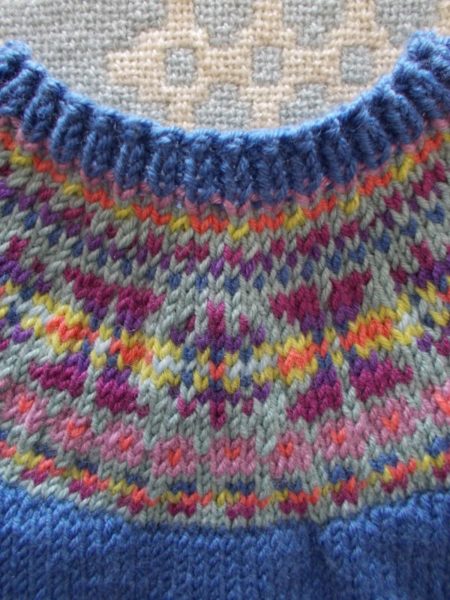
Up close, back yoke: Cardigan with Fair Isle Yoke 9-12 months from Debbie Bliss Baby Cashmerino (pub 2001) Fair Isle design taken from Mary Jane Mucklestone’s 200 Fair Isle Designs
The cricket teas were also a thing unto themselves and based heavily around sugar. Once lunch had been cleared away, out would come industrial sized tins of jam and multitudinous loaves of wax paper wrapped bread and a small team of helpers (of which I think I was one) would slap butter and jam on to an infinity of bread. As the tea interval loomed, water would be set to boil in oversized urns and giant metal tea pots heaved off shelves ready to do duty, the serried rows of study white earthenware tea cups and saucers neatly set out to await players and onlookers alike. Lines of trestle tables set with alternating plates of cakes and jam sandwiches stood as grand as for any feast in that brief quiet time between the end of frenetic preparation and the descent of the hordes. (No cans of Coke, no cakes in wrappers.) There were just three foods I had no liking for at home – tea (from a teapot), jam sandwiches and potatoes. But put me in a cricket pavilion and a cup of tea and a jam sandwich tasted as good as anything I could think of! The ground keeper’s wife was a wonderful warm, kindly woman with a ready smile and a real presence – rather like those farmer’s wives that appear in Enid Blyton’s Famous Five books who produce salad lunches, with thick slices of ham, bushy lettuce and garden new potatoes dripping in butter, almost out of nowhere just as our team of heroes stumble into the safety of the farm after a daring adventure seeing off gangs of criminals. (Associations are strong, I was probably reading such books at the time.)

Sample Fair Isle bands
I grew older but never lost my love of the game of cricket and it threaded through subsequent years like a knotted line of tinsel – sometimes as background, at other times almost taking over life. When I was young, summers were full of test cricket on the television (sometimes battling for air time with Wimbledon) and during winter I would often be found with a radio under the blankets listening to cricket commentary of Test Matches in Australia. My Oxford college, Lady Margaret Hall was right next to the University Parks and I would often snatch a bit of time to watch matches and especially to see Imran Khan (now President of Pakistan) in the field who looked amazing as he came in to bowl with his thick, flowing black mane of hair. Once a visiting team included a young member of a family my brother had played cricket with at Nottingham High but I just wasn’t brave enough to seek him out and introduce myself. My first boss, after university, was the Administrator of the Clarendon Laboratory in Oxford (from my office you could just see a bit of the university cricket pitch). He was a keen cricket fan and memorably had lost his sight standing on the steps of the pavilion at Lords as his retina detached. I once went with his wife to watch a test match from the women’s stand – in the days when women weren’t allowed to be members, let alone allowed in the pavilion. Years later, my son played a lot of cricket, for his school, Latymer Upper, for the local club team, Turnham Green and for London Schools (with nets every Friday evening at Lords Indoor School), for whom he would regularly open the batting with (Sir) Alistair Cook (then also the side’s wicket keeper.)

Back of cardigan with Fair Isle Yoke 9-12 months from Debbie Bliss Baby Cashmerino (pub 2001) Fair Isle design taken from Mary Jane Mucklestone’s 200 Fair Isle Designs
And where else but from Test Match Special would I discover Marmite have joined with Lynx to produce not only body lotion but deodorant! Canny product marketers had sent samples of both to Jonathan Agnew of TMS. The deodorant he pressed on another of the team to try, though with social distancing in place, no one was able to tell that he smelt any different! We were expecting the body lotion to be tested today but as biblical amounts of rain have fallen and are falling, cricket and body lotion testing are postponed until tomorrow, which the weather forecasters say should be better. There’s hope for an England win tomorrow, though with a full day lost to rain, that will take either luck or phenomenal skill. Here’s hoping for both!
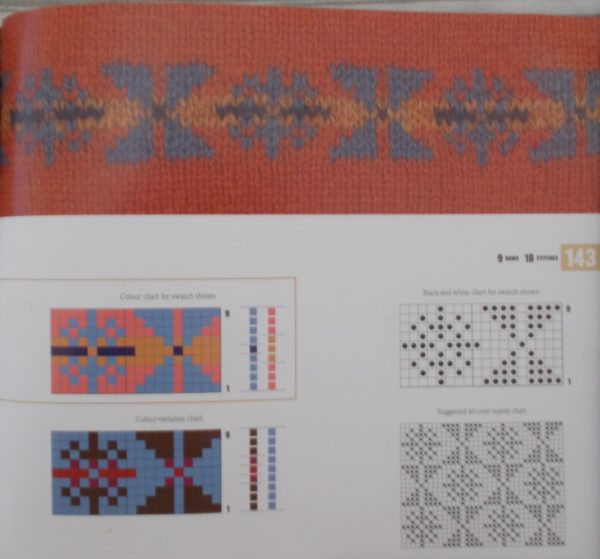
Design 143 from Mary Jane Mucklestone’s ‘200 Fair Isle Designs’.
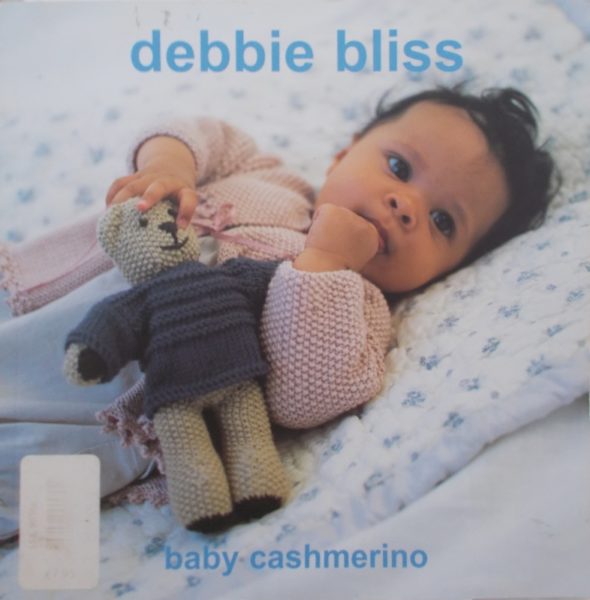
Debbie Bliss Baby Cashmerino (pub 2001)

